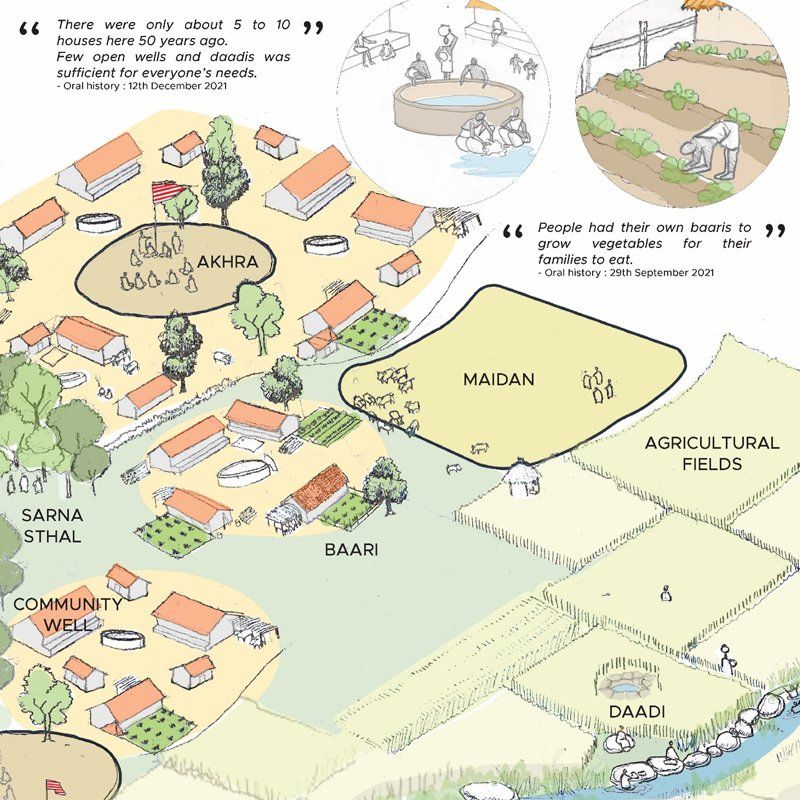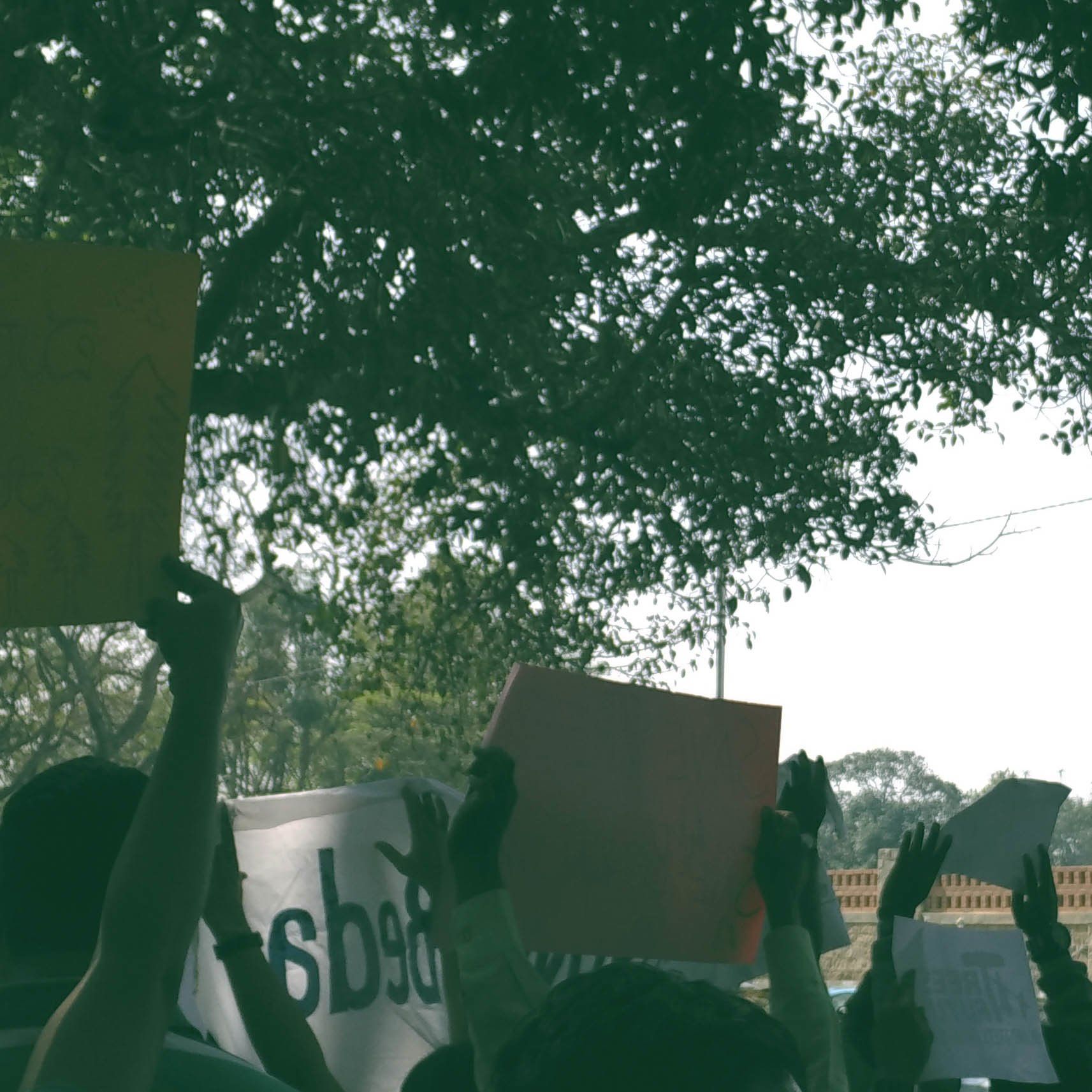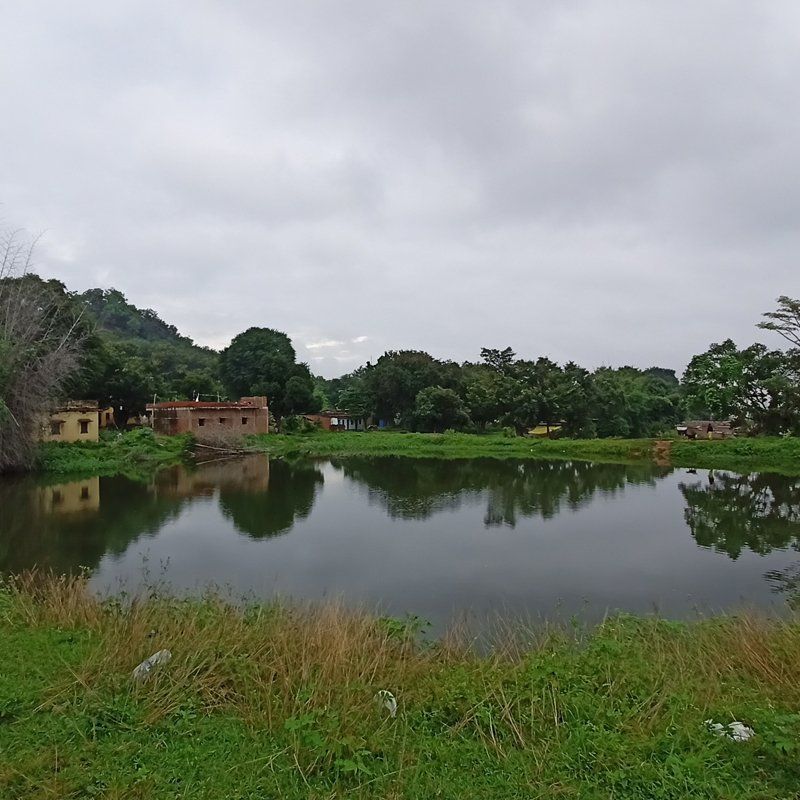But Naturally
Himanshu Burte for Business Standard • January 20, 2013
The bamboo dome of India’s pavilion at Shanghai’s Expo 2010 offers a fresh, green vision for the architectural future.
Can a mere bamboo dome pose important questions about the buildings and cities of the future? Surely the urban form of the future will be shaped by industrial materials like glass, steel and aluminium, as in Gurgaon? The designers of the Indian pavilion at Expo 2010 in Shanghai, which opened on May 1, hope that their bamboo dome covered with live vegetation will shake some of these certainties. I have not visited the project, but my discussions with its architects and the available information, drawings and photographs suggest that it deserves more public debate.
BUILDING FOR A SUSTAINABLE FUTURE
The theme of the Expo is ‘Better City, Better Life’. One glance at the pavilion reveals how little it accords with the industrialised world’s vision of the good urban future. It might well be the biggest bamboo dome in the world, but it looks like a cute, even ‘vernacular’ artifact, compared to the Chinese pavilion. The latter is stereotypically ‘futuristic’ — a big, shiny, whale-meets-spaceship form built with high-technology materials.
The contrast between the two buildings is a contrast in philosophy. The design of the Indian pavilion showcases an approach to architecture that involves consuming less non-renewable resources (including fossil fuels), and causing less damage to the planet (including by carbon dioxide emissions).
DOME DESIGN
Four Indian architects collaborated on the design. They were Sanjay Prakash, Pradeep Sachdeva and Tanmay Tathagat of New Delhi, and Mohan Rao of Bangalore. All have special expertise in sustainable architecture.
The pavilion (covering 2,800 sq mt and costing about $3 million) is an enclosed area with a domical exhibition space at one end. According to the official design concept, the dome echoes that of a Buddhist stupa, a form which is common to India and China.
Conceptually, it must be said, this design appears forced and looks like a leftover from the old Festival of India pattern book. The traditional stupa, after all, is a solid masonry mound. Domes are hollow, and this one is in very light bamboo. The design is thus a missed opportunity to explore a form that emerges largely from the unique strengths of bamboo as a material.
That said, the structure and vision are important. The dome is deceptively simple in form. Structurally, it resembles a basket placed face down. Thirty-six bamboo ribs spring from the base and converge at the crown. Each rib consists of six bamboos laid end to end and joined together. The ribs are connected by 10 bamboo and four steel rings, at different levels. The steel rings were used mainly to ensure that the bamboo structure was built to the correct geometry on site. There is one concrete ring at the bottom and another at the top.
This structure supports a two-inch-thick outer shell of micro-concrete, covered by a waterproof membrane. On this are fixed three layers of an innovative geo-fabric — a soil substitute that holds and delivers water and nutrients from a drip irrigation system to the green roof. Over 125,000 herbs were hand-planted in a multicoloured pattern. The plants are watered in part with water recycled from the toilets. They help insulate the building while capturing carbon from the air and releasing oxygen. An aero generator (an exhaust fan driven by small drafts created by temperature differences between inside and outside, not electricity) at the top of the dome helps ventilate the indoor space and avoids energy-intensive air-conditioning.
CONCEPTUAL SIGNIFICANCE
The project is significant for three reasons. First, it is ecologically benign. It uses a renewable natural material — bamboo — that grows quickly and degrades completely, leaving little waste. (Incidentally, after the Expo ends in September the dome is slated to be dismantled and re-assembled on another site.)
Second, it is very ‘contemporary’ even if it uses old materials and forms. It is engineered using the latest design techniques (including computerised energy and other simulations) and satisfies the latest international fire and structural safety codes. The management protocols involved in its construction were like those of any major international project.
And third, it shows that a big niche exists between high-tech, on the one hand, and crafts-skills in construction, on the other — which is relevant even for prestigious international projects.
FUTURE PROSPECT
The project makes a strong case for a scientific exploration of natural and renewable materials, especially bamboo, in building. It shows that one does not have to use large quantities of cement, steel and glass to achieve sensible architectural goals attractively. Quite the reverse. Industrially produced construction materials like cement, steel, glass and aluminium consume huge amounts of fossil fuel energy.
Meanwhile, India is rich in natural materials and techniques of building with them. In recent decades, Indian architects and engineers have developed dependable ways of constructing modern buildings in bamboo, mud and stone. The future clearly belongs to the sensible application of technological advances to maximise the effectiveness of natural materials.
If this bamboo dome sparks a debate on these issues, in India and elsewhere, it will have more than paid for itself.
BUILDING THE DOME
This was a challenge because of the sheer newness of the idea as well as the collaborations involved. Reconciling different technical visions from different countries and fields was part of the challenge.
Design-C (led by D R Naidu), a unit of HTA Pvt Ltd, was lead designer. It was appointed by the client, the India Trade Promotion Organisation. Architectural design and detailing were the joint effort of four architects and their firms (see main story). Dr Simon Velez, a Colombian authority on bamboo construction, was a special consultant. Lead contractors Shibu C, and local contractors China Jingye were responsible for ensuring that the design met the local building code.
The bamboo chosen was the edible Chinese Moso (Mao-Zhu, or ‘hairy bamboo’), sourced from Anji district 200 km west of Shanghai. A bamboo furniture factory agreed to process the bamboo. There, the bamboo was treated with hot boric-borax and lightly curved in a jig.
Joints were a crucial area of detailing. Tolerance for natural size variations in bamboo pieces had to be built in, to ensure the final form had a perfect geometry. Small quantities of industrial materials were judiciously used to make sure the final shape was right. Steel bolts were used to join bamboos together, and cement grout injected into the bamboo nodes near the joints. To absorb the differences in diameter of bamboo pieces at joints, a steel plate larger than the largest diameter was used. This plate also acts as a stopper for the cement grout in which the bolt is embedded.
CHOOSING THE PLANTS
Mohan Rao of Integrated Design, Bangalore, was responsible for landscape design (‘greening’ the dome). He describes the complex task:
“A two-hour drive would take us to nurseries where I would choose a plant, whose name was noted based on the nursery person’s pronunciation in Mandarin, validated and corrected by another Chinese person later. This then was used to track down the nearest common Mandarin/English plant name. More tantrums and sleepless nights led to its Latin name, all of which were recorded based on its growth character, flowering season, water requirement, medicinal properties, etc. I personally did this with the help of two Indians, two Shanghainese, one French [person] and one Chinese-American over five weeks. The compiled list was vetted and the species shortlisted in subsequent visits — four times over!”
To Rao’s dismay, the challenges of intercultural communication almost led to his work being overlooked by the contractors. Some quick action — involving Rao clambering about on the dome to redraw the pattern within a few hours — saved the day.
THE TREE OF LIFE
The pattern on the plant-covered dome is derived from the stone carved jali depicting the ‘Tree of Life’, in the Siddi Syed Mosque in Ahmedabad. The ‘branches’ are beaten copper sheets, and literally hold the entire composition together. A variety of plant material that changes with the seasons, represents the ‘leaves’. The tree pattern visually integrates the energy-producing components of the pavilion (the photovoltaic panels and aero generator), and helps the pavilion always ‘face’ the viewer, no matter what angle it is seen from.
This article was first published in Business Standard on July 18 2010

Being a member of the Adaptation Research Alliance, ARA (a global, collaborative effort to increase investment and opportunities for action research to develop/inform effective adaptation solutions) and an ARA Micro grantee, Integrated Design (INDÈ) was invited to organise a networking session at the Global Gobeshona Conference-2 (conference theme: exploring locally led adaptation and resilience for COP27). The networking session was titled ‘Situating Urban (City) Resilience within the City-Region’ and was held on 1 April 2022.

The online magazine SustainabilityNext carried an article by Benedict Paramanand titled “Has Fatigue Set into Civic Activism in Bengaluru?” The article caught my eye amidst the Covid 19 humdrum as I was looking for alternative news. I have been actively engaged in the debates around the (ill)growth and mis(management) of Bangalore for over two and half decades in my capacity as a professional planner straddling civic society, public policy circles and academia. The article revived in my mind some thoughts and suggestions that I articulate here. The attempt is not so much to answer the question, as it is to understand the shortcomings and limitations of civic activism in steering the complex politico-socio-economic and cultural layers that make up a vast conglomeration like Bengaluru. A disclaimer here merits mention. The premise that no individual stakeholder, public or private, has the knowledge and resources to tackle the wicked problems underpins successful governance arrangements. What this premise implies, by extension is that all stakeholders – public or private – have limitations. Civic Society (CS) is one amongst the numerous stakeholders that have a role – by no means a lesser one- to play. Yet, there are limitations to this role. While these limitations are embedded in the very nature of operation of the CS, there are conscious ways and means of overriding some limitations to move towards a larger impact. Bridging limitations is a critical need. Much of what I articulate while contextual to Bengaluru, perhaps holds true for civic activism across domains and geographies. To begin with, a critical question requiring reflection is the difference between civic activism and the much advocated (in (good) governance debates) Civic Society Organisation (CSO) engagement. These generally get clubbed in one category – while in theory and practice, that is not the case and therein lies the first limitation. Activism defined as direct vigorous action especially in support of or, in opposition to, one side of a controversial issue is willy-nilly an act of reaction. Reaction often leaves little space for taking distance and exploring the systemic cause of the challenge – the challenge itself sets the agenda. In contrast a proactive engagement of the civic society, through progressive partnerships while also triggered by a challenge is different in that the challenge is anticipated and therefore the agenda is set by civic society themselves. In Bengaluru, protests against the state-imposed flyover (# steelflyoverbeda ) and elevated corridors (# TenderRadduMadi ) is an example of the former. In contrast, the long-standing work on the ward committees which has seen some traction in the recent past – albeit slow and tardy – is an example of the latter. Having started as a proactive CSO engagement, the movement for neighbourhood planning and governance through ward committees (# NammaSamitiNamagaagi ) in the recent past has bordered on being reactionary, thereby hinging on activism. Although an ‘always proactive approach’ is not possible, given the capacity of our government to spring surprises, it is critical that the CS begins to move towards a proactive stance. There will always be a non-uniform interplay between being reactive and proactive. A second limitation, linked to the first, is the lack of capacity of the CS to act on relevant and practical evidence. This will require the CS to open their doors and develop progressive partnerships, including partnerships with policy makers, professionals (note that I do not use the word experts) and academia. An all-time reactionary mode of operation allows neither for collaborations nor evidence. Evidenced advocacy and conversations require domain knowledge (experienced domain knowledge is even better) which can facilitate knowledge production and mobilization. Activism hinges on passion (amongst other drivers) which is not the same as domain knowledge and knowledge mobilization. Both passion and domain knowledge have a role, yet the two can neither replace each other nor should be confused. Rather, passion that pivots on evidence and knowledge is a double-edged sword, one that has the capability to steer reactionary behavior to an informed proactive engagement. Such a move will serve to, over a period of time, course correct policies that are currently influenced by dominant political structures, electoral volatility and elite capture, as against being evidence based. A third limitation that needs consideration is the nature, purpose, goal and objective of the civic society coalition/group. Most often mobilisation is around a seemingly common purpose, goal and objective. For instance, groups that coalesced against large infrastructure projects as mentioned above or the demand for footpaths and public transit (# BusBhagyaBeku ) and sub-urban rail (# chukuBukuBeku ) are not homogeneous. It is often a mixed bag as against an imagined and perhaps desired integrated unit. Underpinning this pursuit of collective goals and objectives are individual desires, identities (which in themselves are multiple), beliefs, perspectives and previous experience, all of which are critical drivers, often leading to fragmented voices. This fragmentation notably, also derives from the inability to use evidence or domain knowledge. Elitist Activism Furthermore, activism in itself is and can be elitist. When linked to high levels of access it can be potentially hampered by what is referred to as ‘elite capture’. There are two types of activism: elite activism stemming from mobilization of charismatic individuals capable of getting their voice heard. Mass activism, in contrast, is where the general public, the haves and the have-nots, mobilize collectively. The two are not mutually exclusive, although both are critical. Barring a few occasions, Bengaluru’s activism has been elitist with a few voices that can access public policy corridors and therefore get heard. Consequently, consciously or unconsciously there is a leveraging of public policy for personal or limited gains (to a neighbourhood or a community). Activism is a luxury that not everyone can afford. Those who can afford it have a dual responsibility of using it to build bridges by roping in knowledge and experience on one hand and ensuring inclusion by creating spaces and opportunities for mass activism, on the other. The current modus operandi lacks on both counts. These shortcomings have led to what is being referred to as limited success, although limited from whose lens and success for whom is an additional enquiry, one that merits a separate post. What I do concur with is that at best the city has seen some cosmetic changes. Let me take the same two examples the article uses to demonstrate a going forward beyond cosmetic progress. First are the lakes in Bangalore that have seen a fair bit of activism. In many neighborhoods, thanks to the many charismatic residents, lakes have been claimed as better maintained natural resources. But for the initiatives of a few citizens, many lakes would have morphed into real estate projects. Yet, the same groups have done little to engage the larger neighborhoods to ensure that these natural resource ‘spaces’ become public ‘places’ for the neighborhood and the city. This would require a proactive engagement in identifying the larger neighborhood and the numerous linkages – backward and forward – that this neighborhood has had and can nurture with the lakes as public places. The second is the Tender Sure roads pioneered by Bengaluru. The implementation of Tender Sure roads is progressing incrementally moving from a pilot in the city core to radiating outwards in various directions. Putting aside the debates on the efficacy of the design as well as the appropriateness and relevance of the idea, the incremental implementation is marked by controversies on the criteria to shortlist roads such that both the visibility of and utility to the neighborhood and the city can be maximized. This too has not happened. Both these examples offer a critical insight: that the activism (and the few instances of engagement) has not translated into a thinking city. Changes are still hovering around the thinking individual. The transition to a thinking city is an emerging imperative, one that demands systemic change along various dimensions, some of which I have discussed above. To sum-up, sustained and big bang change as against cosmetic and incremental change is the need of the hour. It requires at the outset, one, more proactive engagement and less reactive activism; two, passion combined with experienced domain knowledge to trigger evidenced advocacy and change; and, three a less fragmented approach through creating meaningful spaces for mass activism along with the existing elite activism that the city has. While there may be numerous ways to act on these three, the Ward Committee space offer a ready platform for proactive action, evidence-based advocacy and wider participation. Arguably, this space is rife with political contestations and may seem a daunting challenge, yet, an engagement within this space is a surer foot forward. Clearly, there is a passion amongst Bangalore’s elite to be part of something bigger and this is a moment to be seized.


